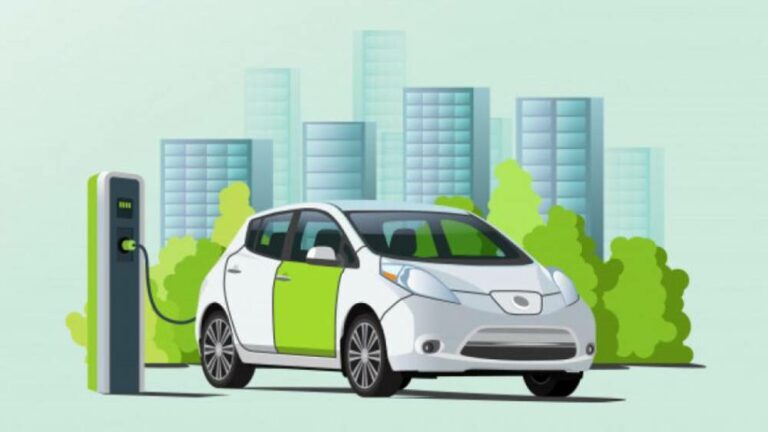The recent EV policy holds significant importance in light of India’s ambitious climate objectives set for 2030 and 2070, aiming to decrease GDP emissions intensity by 45 per cent by 2030 and achieve net-zero emissions by 2070. With this new policy, the Indian market will witness a surge in EV options, as many domestic manufacturers, with few exceptions, have so far adopted a cautious stance.
The Indian government has unveiled a significant shift in policy for the automobile sector, announcing a reduction in import duties on electric vehicles (EVs) contingent upon manufacturers’ commitments to domestic production. In a surprising turn of events, the government unveiled a new electric vehicle (EV) policy on March 15, 2024, just before the Model Code of Conduct was set to take effect.
Under this new policy, import duties on electric cars in India priced above $35,000 (Rs 29 lakh) have been dramatically reduced from the existing 70-110 per cent to a mere 15 per cent for five years. However, this reduction comes with several conditions. The lowered tariff applies to a maximum of 8,000 cars annually and is contingent upon companies investing Rs 4,150 crore or $500 million within three years to establish a manufacturing facility. Additionally, there is a stipulation regarding domestic value addition, requiring a 30 per cent domestic value addition within three years, increasing to 50 per cent by the fifth year. The duty exemption on vehicle imports is capped at the invested amount of Rs 6,484 crore, whichever is lower.
The government’s recent policy shift signifies a notable departure from its staunch ‘Atmanirbhar’ stance, wherein it had maintained high import duties to bolster domestic manufacturing. This pivot reflects a willingness to accommodate major corporations, exemplified by months of negotiations with Tesla, one of the world’s foremost electric vehicle manufacturers. In exchange for investment commitments, including a demand to reduce import duties for a specified timeframe, the government has demonstrated a readiness to incentivize large-scale companies. This development underscores the government’s satisfaction in enticing prestigious brands to establish manufacturing operations within India.
The recent EV policy holds significant importance in light of India’s ambitious climate objectives set for 2030 and 2070, aiming to decrease GDP emissions intensity by 45 per cent by 2030 and achieve net-zero emissions by 2070. With this new policy, the Indian market will witness a surge in EV options, as many domestic manufacturers, with few exceptions, have so far adopted a cautious stance. This initiative is poised to compel internal combustion engine manufacturers in India to develop comprehensive EV market strategies. Consequently, competition is expected to intensify, particularly in the premium category, while Indian manufacturers remain well-positioned to compete effectively in the sub Rs 30 lakh price segment.
Execution Hurdles
The Indian government is facing a formidable challenge in achieving its ambitious goal of attaining a 30 per cent share of Electric Vehicles (EVs) in the cars sold by 2030. This objective presents an opportunity for various EV manufacturers, notably Tesla, to capitalize on the regulatory environment. Even established players like China’s BYD, dominant in the electric car market, might consider entering the Indian market, albeit with the requirement of additional permissions due to geographical constraints.
Tesla’s unique “Gigafactory” model, consolidating a significant portion of car components within a single facility, aligns well with the potential for streamlined agreements under such regulations. However, fostering an EV ecosystem demands more than the introduction of a solitary manufacturer; it necessitates the establishment of an entire network of supporting companies, each with its intricate supply chain. Achieving this entails not merely reducing tariffs on final products but rationalizing tariffs on intermediate goods and inputs to facilitate the formation of global value chains.
There are pertinent concerns regarding the obligations that investors must fulfil in exchange for tariff concessions. Monitoring compliance with investment and localization requirements poses a considerable challenge. Companies granted concessions may seek delays in meeting these targets, raising questions about the government’s recourse in such instances. Would duty concessions be revoked if promised investments fail to materialize or if a new factory remains insufficiently localized within the stipulated timeframe? The enforcement of such measures, whether borne by consumers or companies, remains uncertain.
The adoption of similar concession-based mechanisms in other sectors could significantly complicate trade policy. Ideally, trade policies should maintain low and stable tariffs, particularly in sectors pivotal for integrating into global value chains. Concession-based approaches, while potentially innovative, tend to undermine policy consistency and accountability. While India undeniably requires substantial investments across various sectors, policymakers must balance the imperative for innovation with the allure of simple and stable policies, which often attract greater business interest and investment inflows.
E-Vehicle policy to Promote India as a Manufacturing Destination
The Government of India has approved a scheme to promote India as a manufacturing destination so that e-vehicles with the latest technology can be manufactured in the country. The policy is designed to attract investments in the e-vehicle space by reputed global EV manufacturers.
This will provide Indian consumers with access to latest technology, boost the Make in India initiative, strengthen the EV ecosystem by promoting healthy competition among EV players leading to high volume of production, economies of scale, lower cost of production, reduce imports of crude Oil, lower trade deficit, reduce air pollution, particularly in cities, and will have a positive impact on health and environment.
The policy entails the following: –
- Minimum Investment required: Rs 4150 Crore (USD 500 Mn)
- No limit on maximum Investment
- Timeline for manufacturing: 3 years for setting up manufacturing facilities in India, and to start commercial production of e-vehicles, and reach 50% domestic value addition within 5 years at the maximum.
- Domestic value addition during manufacturing: A localization level of 25% by the 3rd year and 50% by the 5th year will have to be achieved
- The customs duty of 15% (as applicable to CKD units) would be applicable for a period of 5 years
- Vehicle of CIF value of USD 35,000 or above will be permissible
- The total number of EV allowed for import would be determined by the total duty foregone or investment made, whichever is lower, subject to a maximum of Rs 6,484 Crore (equal to incentive under PLI scheme).
- Not more than 8,000 EVs per year would be permissible for import under this scheme. The carryover of unutilized annual import limits would be permitted.
- The Investment commitment made by the company will have to be backed up by a bank guarantee in lieu of the custom duty forgone
- The Bank guarantee will be invoked in case of non-achievement of domestic value addition and minimum investment criteria defined under the scheme guidelines.
Is it a sensible policy?
The new policy blends classical and modern economic theories to form its economic rationale. Key features such as reduced tax rates, guaranteed investment thresholds, and a focus on domestic manufacturing (Make-in-India) reflect a heterodox economic approach. Drawing from elements of supply-side economics, the theory of comparative advantage, and infant industry arguments prevalent in India’s recent industrial planning, the policy prioritizes stimulating economic growth by boosting production rather than solely focusing on demand.
In particular, the policy encourages the creation of a domestic electric vehicle (EV) manufacturing industry, aligning with the principle of comparative advantage, where countries specialize in producing goods efficiently. By offering incentives, such as temporary tax breaks, the policy supports the development of the domestic EV industry, akin to the infant industry argument, which advocates for temporary protection to help nascent industries compete globally.
Furthermore, the presence of global players in the domestic market is expected to facilitate knowledge transfer and collaborations with domestic companies, fostering innovation in the Indian EV sector. This approach aims to build a robust domestic EV ecosystem, encompassing both large and small industries, including MSME component manufacturers, service providers, and research institutions.
While the policy may result in an initial decline in revenue due to reduced tariffs on imported electric vehicles, it foresees significant long-term advantages. These include increased tax revenue from domestic production, the generation of new employment opportunities, and overall economic growth. Furthermore, by offering affordable and high-quality e-vehicles to Indian consumers, the policy aims to attract investments, promote local manufacturing, and drive technological advancement, positioning India as a prominent player in the global electric vehicle industry.
The recent unveiling of the government’s EV policy marks a strategic amalgamation of incentives and actionable targets, poised to position India as a premier production hub for global automotive giants eyeing the burgeoning EV market worldwide. While undoubtedly influenced by Elon Musk’s Tesla, which had pressed for import duty reductions before contemplating local assembly, it’s imperative to note that the policy doesn’t offer unwarranted advantages to any single entity.
India’s automotive landscape boasts a robust presence of international manufacturers with well-established manufacturing infrastructures, primarily focused on internal combustion engine technology. However, the EV segment remains relatively nascent, constituting a mere one per cent of the passenger vehicle market, with luxury EVs, where Tesla operates, commanding a modest 3-4 per cent share. Hence, offering incentives to spur investments in this burgeoning domain is not only prudent but essential to incentivize manufacturers to reconfigure their supply chains.
Drawing parallels with successful incentive-driven schemes in sectors like electronics and semiconductors, the government’s approach to tie duty concessions to EV production facilities echoes a proven methodology. Moreover, by mandating companies to support their commitments with bank guarantees, rather than simply forgoing duties, the policy underscores accountability, ensuring adherence to investment obligations.
Critically, the policy’s equitable stance opens avenues for a multitude of global players, fostering healthy competition. Despite the availability of 15 EV models in the market, predominantly imported, with only two being domestically assembled, the policy aims to level the playing field. Domestic EV manufacturers, predominantly catering to lower-price segments, stand to benefit without undue prejudice.
While the policy framework exhibits foresight, its successful execution hinges on effective implementation. Manufacturers opting for incentives will necessitate suitable land parcels and robust ancillary industries to meet local value-addition requirements. However, the acquisition of land and fair compensation processes must be expedited to avoid missing deadlines. Any lapses could trigger legal complications, particularly regarding the encashment of bank guarantees, which inherently favour the government.
Looking ahead, the policy’s efficacy rests on forthcoming reforms, particularly in streamlining land acquisition processes, as articulated by the government’s emphasis on factors of production. Swift and seamless implementation of these reforms will be pivotal in realizing the policy’s overarching objectives and solidifying India’s position as a global leader in EV manufacturing.





















